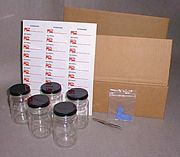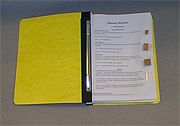Materials such as wood, plywood, paint and fabric can emit harmful vapors into a closed environment, subjecting the collection materials to damage. Acid migration from wood is especially harmful to paper and textiles, causing yellowing and embrittlement. Corrosive volatiles, released by certain glues, paints, fabrics, and urea formaldehyde in plywood, cause metals to corrode. Air circulation in the storage room will dilute acid fumes.
More information on recommended materials and how to test materials is available inExhibiting.
|
MS201: Storage for Infinity: An Overview of Museum Storage Principles (Only once in 2013) Course Description & Info Instructor: Lori Benson Student Login Price: $475 Mar 4 – Mar 29, 2013 [Learn More]
| |
|
MS204: Materials for Storage and Display Course Description & Info Instructor: Gretchen Anderson Student Login Price: $495 Nov 4 – Nov 29, 2013 [Learn More] Sep 1 – Sep 26, 2014 [Learn More]
|
Books and products we recommend:
 Materials Testing Kit Acid fumes are a danger to any collection. This kit provides information and supplies to aid in the testing of construction materials. The Materials Testing Kit includes 24 glass jars, acid detection strips, tweezers, silver coupons, lead coupons, aluminum foil, 1 sheet of preprinted labels and an instruction manual.
Materials Testing Kit Acid fumes are a danger to any collection. This kit provides information and supplies to aid in the testing of construction materials. The Materials Testing Kit includes 24 glass jars, acid detection strips, tweezers, silver coupons, lead coupons, aluminum foil, 1 sheet of preprinted labels and an instruction manual.
| Materials Testing Kit | $120.00 | |
|
Polished lead coupons (24) | $22.15 | |
|
Polished silver coupons (24) | $24.95 | |
| Materials Testing Kit Booklet | $15.00 |
 Museum Materials sample booklet Ordering archival supplies can be difficult and confusing. This booklet provides sample materials of the most common supplies currently offered and discusses how they are used in museums. Organized by function, the booklet covers rigid materials, padding materials, ties and attachments, barrier materials and "bad" materials.
Museum Materials sample booklet Ordering archival supplies can be difficult and confusing. This booklet provides sample materials of the most common supplies currently offered and discusses how they are used in museums. Organized by function, the booklet covers rigid materials, padding materials, ties and attachments, barrier materials and "bad" materials.
| Museum Materials sample booklet | $45.00 |
 CCI Tech Bulletin #14 Working with Polyethylene Foam and Fluted Plastic Sheet by Carl Schlichting
CCI Tech Bulletin #14 Working with Polyethylene Foam and Fluted Plastic Sheet by Carl Schlichting
Examines several techniques and illustrates a series of basic approaches that have been developed for working with polyethylene foam and fluted plastic. The many detailed illustrations clarify for the reader the fabrication methods described in the text.
| Working with Polyethylene Foam & Fluted Plastic | $18.00 |
NSCC Museum Materials Training Workshop
Links to related information on other sites:
Why Use Archival Storage Products?
http://www.angelfire.com/biz/origins1/archival.html
Buffered and Unbuffered Storage Materials (Conserve-O-Gram 4/9) – (An Adobe PDF file)
http://www.cr.nps.gov/museum/publications/ conserveogram/04-09.pdf
Making Mounting Corners for Photographs and Paper Objects (Conserve-O-Gram 14/1) – (An Adobe PDF file)
http://www.cr.nps.gov/museum/publications/ conserveogram/14-01.pdf
Storage Enclosures for Photographic Prints and Negatives (Conserve-O-Gram 14/2) – (An Adobe PDF file)
http://www.cr.nps.gov/museum/publications/ conserveogram/14-02.pdf
